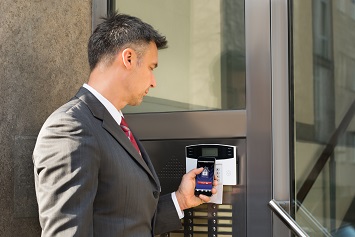Effective managers continually source innovative solutions and implement them. This requires a ready eye and ear for opportunities. Access control is the next opportunity that is almost literally knocking at the door. The access control model pre-COVID is gone. Smart solutions in touchless access control like mobile access, cloud-based systems, video intercom, and facial recognition ID for employee and visitor management systems change the game, and facilities managers need to understand them.
Recent Innovations in Touchless, Smart Solutions and Access Control
Here are some of the highlights of touchless access control to track.
Sophisticated Video Intercom Systems
Intercoms are a safe and secure way to communicate using video or audio. The communication could be between two offices within a building, an office and the front door, or offices in different locations. A video intercom (which activates via motion detection) is invaluable to touchless access control and visitor management systems, as it helps to verify a visitor visually. The kind of connection and communication you want to establish will determine the best intercom system for you.
Mobile Access
NFC- and Bluetooth-enabled smartphones, tablets, and electronic wearables are fast replacing the keycard system. Like cloud-based systems in general, the use of mobile devices not only offers the advantage of real-time reports but also allows instant changes to user permissions, even from remote locations. Touchless access control systems are dependent on facial recognition and mobile access.
Fever-Scanning Technology
In some locations, temperature checks are mandatory before entry. While most companies rely on hand-held temperature scanners, more sophisticated solutions include a combination of thermal imaging cameras, facial recognition, and cloud-based technology. The system alerts the management dashboard in real time if a high temperature is detected. This is one way smarter workplaces can help us recover faster.
Improved Facial Recognition
With facial recognition, images of employees are saved as templates on the database. When staff approach the door or entry point, their image is captured and compared with the available templates to determine access. This method of access control is genuinely hands-free and promotes a touchless culture. In recent years, the technology has improved dramatically.
What Do Facilities Managers Need to Know?
Increase Security with Facial Recognition ID
Many companies are making the switch to touchless systems with facial recognition technology. With increasing accuracy and lower matching errors, facial recognition offers superior security to other biometric technologies. It eliminates the need for keycards, which avoids problems like missing cards, stolen cards, and other drawbacks of keycard access control systems.
Increase Cybersecurity with the Cloud
Companies have squeezed most of the useful life out of their on-premises legacy access control and security systems. Those systems may have come to the end of the line with the arrival of COVID-19. Cloud-based technology makes it possible to grant or revoke access to a facility from anywhere remotely. This offers an immediate response to a security breach and results in precious time saved.
Allow for Remote Capabilities
Many companies are considering allowing most staff to work from home. With touchless access and cloud-based systems, remote management of access control is simple. As the specter of COVID-19 eventually recedes, remote management will keep growing as society continues becoming more and more mobile.
Increase Health and Safety Without Having to Touch Surfaces
Touchless access control creates a hands-free environment—and, quite possibly, the difference between sickness and health. Reducing touchpoints becomes critical, with health and safety of paramount priority.
Access Control Protocol for Managing Visitors
How an organization manages its facilities’ visitors is a testament to its professionalism, a component of its reputation, and a determinant of legal liability. An excellent visitor management system addresses convenience, speed, privacy, comfort, health, and safety. Today’s visitors are wary and on edge, and a touchless visitor management system can put them at ease.
Some Concerns Around Facial Recognition
Facial recognition arrived to much hype a couple of decades ago, and unsurprisingly, it had some underwhelming performances in the early days. Here are some of the early—and more recent—failures of facial recognition technology:
- Video surveillance systems were marketed as facial recognition scanners. Surveillance cameras aren’t equipped for access control and suffered significant matching errors.
- The use of low-cost Chinese products sparked some privacy concerns and attracted sanctions from the U.S. government.
- Early facial recognition readers were expensive and complicated and lacked the support of cloud-based systems.
Improvements in Facial Recognition
- End-to-end encryption of data from all devices and secure storage of data greatly reduce privacy risks.
- The integration of facial recognition with cloud-based access control creates a seamless system of operation.
- 3D face checks now make it almost impossible to trick the system. Thus, facial recognition is more secure than ever.
- The use of artificial intelligence (AI) in facial recognition increases its efficiency. Facial recognition can seamlessly adapt to changes like weight loss, facial hair, and a makeover.
Key Takeaways
- Touchless systems are here in time for COVID and its aftermath.
- Mobile access, video intercoms, and facial recognition offer touchless solutions for organizations to get back to full operation.
- Cloud-based systems provide more security, convenience, and flexibility than on-premises systems.
- Health and safety are primary concerns for a visitor management system.
 Melvin Braide Braide is a professional content writer and copywriter at Swiftlane, with a degree in Mechanical Engineering and years of experience writing across various niches. Melvin focuses on providing valuable and educational content for Swiftlane’s growing audience in the areas of access control, visitor management, and security. Melvin Braide Braide is a professional content writer and copywriter at Swiftlane, with a degree in Mechanical Engineering and years of experience writing across various niches. Melvin focuses on providing valuable and educational content for Swiftlane’s growing audience in the areas of access control, visitor management, and security. |

